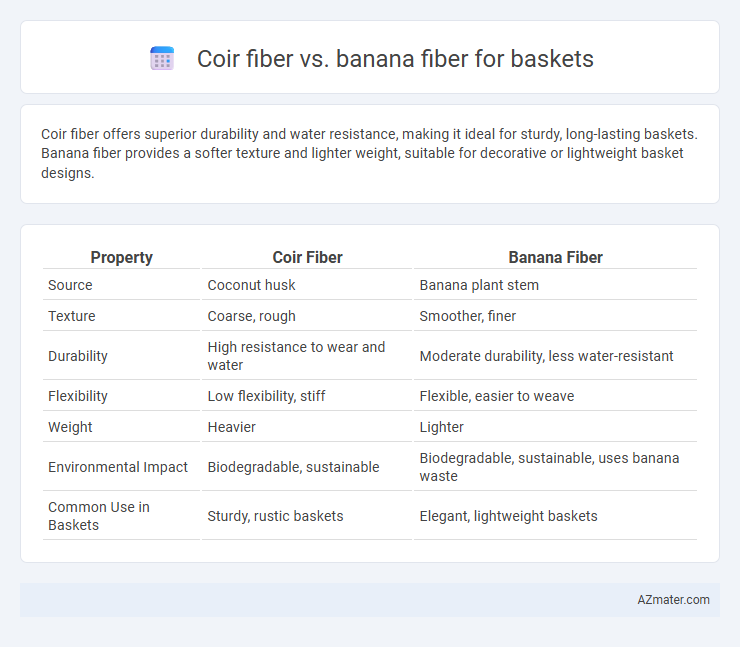Coir fiber offers superior durability and water resistance, making it ideal for sturdy, long-lasting baskets. Banana fiber provides a softer texture and lighter weight, suitable for decorative or lightweight basket designs.
Table of Comparison
| Property | Coir Fiber | Banana Fiber |
|---|---|---|
| Source | Coconut husk | Banana plant stem |
| Texture | Coarse, rough | Smoother, finer |
| Durability | High resistance to wear and water | Moderate durability, less water-resistant |
| Flexibility | Low flexibility, stiff | Flexible, easier to weave |
| Weight | Heavier | Lighter |
| Environmental Impact | Biodegradable, sustainable | Biodegradable, sustainable, uses banana waste |
| Common Use in Baskets | Sturdy, rustic baskets | Elegant, lightweight baskets |
Introduction to Natural Fibers for Baskets
Coir fiber, derived from coconut husks, is known for its coarse texture and durability, making it ideal for sturdy baskets that require resilience and moisture resistance. Banana fiber, extracted from the pseudostem of banana plants, offers a smoother texture, flexibility, and a lightweight quality suitable for decorative and intricately woven baskets. Both natural fibers provide eco-friendly alternatives to synthetic materials, with coir excelling in strength and banana fiber prized for its aesthetic appeal and softness.
Overview of Coir Fiber: Source and Key Properties
Coir fiber, derived from the outer husk of coconut shells, is renowned for its durability, water resistance, and coarse texture, making it ideal for basket weaving that demands robustness. This natural fiber exhibits high lignin content, contributing to its stiffness and resistance to abrasion and microbial attacks. In comparison to banana fiber, coir offers superior moisture resistance, ensuring baskets maintain their shape and functionality in humid environments.
Overview of Banana Fiber: Source and Key Properties
Banana fiber, derived from the pseudostem of the banana plant, is a sustainable and eco-friendly natural fiber known for its strength and durability. Its coarse texture and high tensile strength make it ideal for creating sturdy baskets with a rustic appearance. Unlike coir fiber, banana fiber offers better flexibility and a smoother finish, enhancing both the aesthetic and functional qualities of handmade baskets.
Strength and Durability: Coir vs Banana Fiber
Coir fiber exhibits superior strength and durability compared to banana fiber, making it ideal for heavy-duty baskets that require robust structural support and resistance to wear. The coarse texture and high lignin content in coir contribute to its exceptional toughness and moisture resistance, extending the basket's lifespan in humid or wet conditions. Banana fiber, while softer and more flexible, offers moderate strength but lacks the same durability and resilience against abrasion and prolonged exposure to moisture as coir fiber.
Flexibility and Workability in Basket Weaving
Coir fiber boasts moderate flexibility but tends to be coarse and stiff, which can limit intricate basket weaving designs. Banana fiber exhibits superior flexibility and softness, allowing artisans to create more detailed and delicate patterns with ease. The workability of banana fiber is enhanced by its smooth texture and pliability, making it the preferred choice for fine basket craftsmanship compared to the tougher coir fiber.
Aesthetic Appeal: Texture and Color Comparison
Coir fiber offers a coarse, rugged texture with natural brown hues, giving baskets a rustic and earthy aesthetic. Banana fiber possesses a smoother, finer texture with a light cream to pale yellow color, lending baskets a delicate and elegant appearance. The contrast in texture and color between coir and banana fibers significantly influences the visual and tactile appeal of handcrafted baskets.
Environmental Impact and Sustainability
Coir fiber, derived from coconut husks, is highly sustainable due to its biodegradable nature and minimal processing requirements, making it an eco-friendly choice for baskets. Banana fiber, extracted from banana plant stalks, also offers excellent biodegradability and supports zero-waste agriculture by utilizing agricultural byproducts. Both fibers reduce reliance on synthetic materials, but banana fiber production promotes circular economy principles by converting crop residue into valuable raw material.
Availability and Cost Factors
Coir fiber, derived from coconut husks, is widely available in tropical regions and offers a cost-effective material for basket making due to its abundant supply and low processing expenses. Banana fiber, extracted from banana plant pseudostems, tends to be less readily available and often incurs higher costs because of limited production and more intensive extraction methods. Both fibers provide durability, but coir's greater accessibility and affordability make it a preferred choice for large-scale basket manufacturing.
Common Uses and Applications in Basketry
Coir fiber, derived from coconut husks, is widely used in basketry for its durability, water resistance, and coarse texture, making it ideal for outdoor and heavy-duty baskets. Banana fiber, extracted from banana plant stalks, offers a softer, smoother texture and is favored for decorative and lightweight baskets that require flexibility and fine detail. Both fibers are sustainable choices, with coir excelling in rugged applications and banana fiber preferred for artisanal, delicate basket designs.
Choosing the Best Fiber for Your Basket Project
Coir fiber, derived from coconut husks, offers durability and water resistance, making it ideal for sturdy baskets used in outdoor or heavy-duty settings. Banana fiber, extracted from banana plant stems, provides a softer texture and greater flexibility, which is perfect for decorative or lightweight baskets. Selecting the best fiber hinges on the basket's purpose: opt for coir fiber for strength and moisture resistance, while banana fiber suits aesthetic appeal and ease of weaving.

Infographic: Coir fiber vs Banana fiber for Basket
 azmater.com
azmater.com